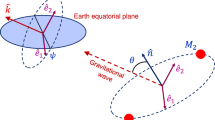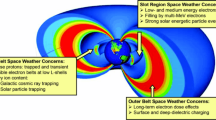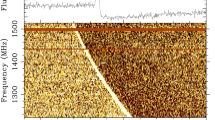Abstract
The DArk Matter Particle Explorer (DAMPE) is a satellite orbiting at 500 km altitude in a Sun-synchronous orbit, taking data from its launch on December 17, 2015. DAMPE is composed by several particle detectors, working together to identify incoming particles and nuclei. Main goals of the DAMPE space mission are: study of cosmic-rays and electron-positron energy spectra, gamma-ray astronomy, and indirect dark matter search. The main results achieved by DAMPE will be presented in this work.


Similar content being viewed by others
REFERENCES
J. Chang et al. (DAMPE Collab.), Astropart. Phys. 95, 6–24 (2017). https://doi.org/10.1016/j.astropartphys.2017.08.005
F. Alemanno et al. (DAMPE Collab.), Sci. Bull. 67, 679-684 (2022).. https://doi.org/10.1016/j.scib.2021.12.015
M. Ackermann et al., Phys. Rev. D 91, 122002 (2015). https://doi.org/10.1103/PhysRevD.91.122002
G. Ambrosi et al. (DAMPE Collab.), Nature (London, U.K.) 552, 63–66 (2017). http://dx.doi.org/10.1038/nature24475
F. Aharonian et al. (The H. E. S. S. Collab.), Phys. Rev. Lett. 101, 261104 (2008). https://doi.org/10.1103/PhysRevLett.101.261104
F. Aharonian et al. (The H. E. S. S. Collab.), Astron. Astrophys. 508, 561–564 (2009). https://doi.org/10.1051/0004-6361/200913323
M. Aguilar et al. (AMS Collab.), Phys. Rev. Lett. 113, 221102 (2014). https://doi.org/10.1103/PhysRevLett.113.221102
S. Abdollahi et al. (The Fermi-LAT Collab.), Phys. Rev. D 95 082007 (2017). https://doi.org/10.1103/PhysRevD.95.082007
Q. An et al. (DAMPE Collab.), Sci. Adv. 5, eaax3793 (2019). https://doi.org/10.1126/sciadv.aax3793
F. Alemanno et al. (DAMPE Collab.), Phys. Rev. Lett. 126, 201102 (2021). https://doi.org/10.1103/PhysRevLett.126.201102
O. Adriani et al. (PAMELA Collab.), Science (Washington, DC, U. S.) 332, 69 (2011);
O. Adriani et al. (PAMELA Collab.), Science (Washington, DC, U. S.) 332, 69 (2011); Adv. Space Res. 51, 219–226 (2013). https://doi.org/10.1016/j.asr.2012.09.029
M. Aguilar et al. (AMS Collab.), Phys. Rev. Lett. 114, 171103 (2015). https://doi.org/;10.1103/PhysRevLett.114.171103
M. Aguilar et al. (AMS Collab.), Phys. Rev. Lett. 114, 171103 (2015). https://doi.org/10.1103/PhysRevLett.114.171103; Phys. Rev. Lett. 115, 211101 (2015). https://doi.org/10.1103/PhysRevLett.115.211101
M. Aguilar et al. (AMS Collab.), Phys. Rev. Lett. 119, 251101 (2017). https://doi.org/;10.1103/PhysRevLett.119.251101
Phys. Rev. Lett. 120, 021101 (2018). https://doi.org/10.1103/PhysRevLett.120.021101; https://doi.org/10.1103/PhysRevLett.124.211102;10.1103/PhysRevLett.120.021101
M. Aguilar et al. (AMS Collab.), Phys. Rev. Lett. 119, 251101 (2017). https://doi.org/10.1103/PhysRevLett.119.251101; Phys. Rev. Lett. 120, 021101 (2018). https://doi.org/10.1103/PhysRevLett.120.021101; https://doi.org/10.1103/PhysRevLett.124.211102; Phys. Rev. Lett. 126, 041104 (2021). https://doi.org/10.1103/PhysRevLett.126.041104
O. Adriani et al. (CALET Collab.), Phys. Rev. Lett. 122, 181102 (2019). https://doi.org/10.1103/PhysRevLett.122.181102
A. D. Panov et al. (ATIC Collab.), Bull. Russ. Acad. Sci.: Phys. 73, 564 (2009). https://doi.org/10.3103/S1062873809050098
H. S. Ahn et al. (CREAM Collab.), Astrophys. J. Lett. 714, L89 (2010). https://doi.org/;10.1088/2041-8205/714/1/L89
H. S. Ahn et al. (CREAM Collab.), Astrophys. J. Lett. 714, L89 (2010). https://doi.org/10.1088/2041-8205/714/1/L89; Y. S. Yoon et al. (CREAM Collab.), Astrophys. J. 839, 5 (2017). https://doi.org/10.3847/1538-4357/aa68e4
E. Atkin et al. (NUCLEON Collab.), J. Cosmol. Astropart. Phys., 2017, 020 (2017). https://doi.org/10.1088/1475-7516/2017/07/020
F. Alemanno et al., PoS (ICRC2021), 117 (2021). https://doi.org/10.22323/1.395.0117
L. Wu et al., PoS (ICRC2021), 128 (2021). https://doi.org/10.22323/1.395.0128
Z. Xu et al., PoS (ICRC2021), 115 (2021). https://doi.org/10.22323/1.395.0115
C. Yue et al., PoS (ICRC2021), 126 (2021). https://doi.org/10.22323/1.395.0126
E. Atkin et al. (NUCLEON Collab.), JETP Lett. 108, 5–12 (2018). https://doi.org/10.1134/S0021364018130015
B. Bartoli et al. (ARGO-YBJ Collab. and LHAASO Collab.), Phys. Rev. D 92, 092005 (2015). https://doi/10.1103/PhysRevD.92.092005
J. C. Arteaga-Velázquez and J. D. Álvarez, PoS (ICRC2019), 176 (2019); arXiv: 1908.11519
K.-H. Kampert et al., Acta Phys. Polon. B 35, 1799 (2004).
A. D. Panov et al., in Proceedings of the 30th International Cosmic Ray Conference (2008), Vol. 2, p. 3; arXiv: 0707.4415v1
H. S. Ahn et al., Astropart. Phys. 30, 133 (2008). https://doi.org/10.1016/j.astropartphys.2008.07.010
O. Adriani et al., Astrophys. J. 791, 93 (2014). https://doi.org/10.1088/0004-637x/791/2/93
M. Aguilar et al. (AMS Collab.), Phys. Rev. Lett. 117, 231102 (2016). https://doi/10.1103/PhysRevLett.117. 231102
Funding
The DAMPE mission was funded by the strategic priority science and technology projects in space science of Chinese Academy of Sciences. In China the data analysis is supported by the National Key Research and Development Program of China(project no. 2016YFA0400200), the National Natural Science Foundation of China (project nos. 11921003, 11622327, 11722328, 11851305, U1738205, U1738206, U1738207, U1738208, and U1738127), the strategic priority science and technology projects of Chinese Academy of Sciences (project no. XDA15051100), the 100 Talents Program of Chinese Academy of Sciences, the Young Elite Scientists Sponsorship Program by CAST (project no. YESS20160196), and the Program for Innovative Talents and Entrepreneur in Jiangsu. In Europe the activities and data analysis are supported by the Swiss National Science Foundation (SNSF), Switzerland, the National Institute for Nuclear Physics (INFN), Italy, and the European Research Council (ERC) under the European Union’s Horizon 2020 research and innovation programme (project no. 851103).
Author information
Authors and Affiliations
Consortia
Corresponding author
Ethics declarations
The authors declare that they have no conflicts of interest.
About this article
Cite this article
Alemanno, F., on Behalf of the DAMPE Collaboration. The DAMPE Space Mission: Status and Main Results. Moscow Univ. Phys. 77, 280–283 (2022). https://doi.org/10.3103/S0027134922020060
Received:
Published:
Issue Date:
DOI: https://doi.org/10.3103/S0027134922020060




